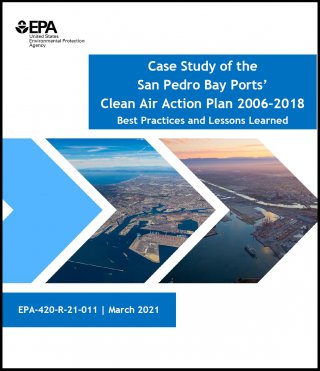San Pedro Bay Ports' Clean Air Action Plan Best Practices and Lessons Learned
 Image of CAAP Case Study Title Page" width="640" height="742" />About the Case Study
Image of CAAP Case Study Title Page" width="640" height="742" />About the Case Study
The Clean Air Action Plan (CAAP) at the Ports of Los Angeles and Long Beach, collectively known as the San Pedro Bay Ports (SPBP), is a groundbreaking program. The Case Study of the San Pedro Bay Ports’ Clean Air Action Plan 2006–2018 provides a summary of the CAAP’s background and history followed by three focused discussions on environmental justice and levers of community influence; technologies and practices for development and deployment; and the 2017 Clean Truck Program. Best practices and lessons learned presented in the case study that other port operators and near-port communities may find useful when implementing air quality actions include the importance of:
- C ollaborating among ports and communities,
- Conducting emission inventories,
- Setting quantified emissions targets,
- Supporting technical innovations, and
- Developing partnerships with industry and government.
Click the link below for the full case study and associated fact sheets.
- Case Study of the San Pedro Bay Ports' Clean Air Action Plans 2006-2018: Best Practices and Lessons Learned (PDF) (34 pp, 772 K, EPA-420-R-21-011, March 2021)
- Fact Sheet: Case Study of the San Pedro Bay Ports' Clean Air Action Plans (CAAP): Highlights and Key Conclusions (PDF) (4 pp, 411 K, EPA-420-F-21-027, March 2021)
- Fact Sheet: Case Study of the San Pedro Bay Ports' Clean Air Action Plans (CAAP): Environmental Justice and Levers of Community Influence (PDF) (2 pp, 143 K, EPA-420-F-21 -029 , March 2021)
- Fact Sheet: Case Study of the San Pedro Bay Ports' Clean Air Action Plans (CAAP): Technologies and Practices: Development and Deployment (PDF) (2 pp, 451 K, EPA-420-F-21 -030 , March 2021)
- Fact Sheet: Case Study of the San Pedro Bay Ports' Clean Air Action Plans (CAAP): The 2017 Clean Truck Program (CTP) (PDF) (2 pp, 147 K, EPA-420-F-21 -028 , March 2021)
CAAP Origins and Background
The San Pedro Bay Ports (SPBP) are the entry point for up to 40 percent of U.S. containerized cargo imports. As the SPBP capacity to transfer cargo expanded with the rapid growth of international trade in the early 2000s, so did diesel-powered vehicles and equipment, that continued the ports’ role as being a large contributor to the region’s poor air quality. In 2000, the South Coast Air Quality Management District (SCAQMD) published a study that reported a high risk of cancer resulted from air pollution from diesel exhaust. The study raised public awareness of the health effects of air pollution, and near-port communities began mobilizing to oppose the Ports’ expansion and demanded action to improve air quality. SPBP leaders were also becoming increasingly aware of a trend toward stricter environmental regulations and saw potential cost savings in taking pre-emptive environmental action. In response, the ports and partners developed the CAAP in 2006, with subsequent revisions in 2010 and 2017. The CAAP reflects a process of continuous stakeholder engagement that can serve as a roadmap for other port operators considering air quality actions and for near-port communities interested in advocating for their health and wellbeing in partnership with ports.
CAAP Development and Implementation
The Ports developed the CAAP to be a living document: each update includes new data and strategies as information and technology became available. Each version of the CAAP addresses the “fair share” of the Ports’ pollutant emissions that were contributing to regional air quality problems; tailors control strategies to specific emission source types (i.e., vessels, heavy-duty trucks, cargo-handling equipment, etc.); and reflects the most recent, accurate annual emissions inventories and estimates. There were two updates to the original 2006 CAAP: 2010 and 2017. Key elements and outcomes of each version are presented below.
- Emission reduction strategies for nitrogen oxide (NOx), sulfur oxide (SOx), and diesel particulate matter (DPM).
- Clean Truck Program (CTP) applied tariffs to oldest/ dirtiest trucks and set a timeframe for banning them from the Ports.
- Technology Assessment Program (TAP) fast- tracks low-pollution equipment technologies through demonstrations, evaluations, assessments, and incentives.
- New quantitative emission reduction targets based on progress from the 2006 targets and refreshed implementation strategies.
- Health risk standard of reducing population-weighted cancer risk from port-related DPM by 85 percent by 2020.
- Greenhouse gas (GHG) emission reduction targets (aligning with state and regional programs and regulations).
- New and updated implementation strategies.
- Formalized public involvement process to ensure local concerns are heard and addressed.
 Lesson Learned: Community-Port Collaboration
Lesson Learned: Community-Port Collaboration
Built on engagement, collaboration, and information sharing, productive community-port working relationships are fluid, time-intensive, and essential to the success of port environmental programs. Community-port collaborations do not need to start with a fully comprehensive clean air plan, and ports just beginning outreach and communication efforts will likely need to take incremental steps.
- Make participation easier for community members by offering flexible meeting times, food, childcare, and other measures.
- Utilize existing processes such as regional air quality and/or transportation planning to encourage port-community engagement.
- Incorporate community representation during the implementation phase, not just the development phase.
- Build relationships with local policymakers, environmental NGOs, labor organizations, and port staff.
- Form alliances with other communities to elevate common issues and amplify environmental justice perspectives on ports and freight movement nationwide.
- Continue to exert strong pressure on ports, regulatory agencies, and industry to quickly develop and deploy low-polluting equipment technologies.
Lesson Learned: Emission Inventories, Quantified Targets, and Technical Innovations
Developing emissions inventories can help ports set quantitative targets and determine where to reduce emissions, while also providing timely information to demonstrate the effectiveness of clean air efforts to the surrounding community. Technical innovations, including through technology demonstrations and changes to operational practices, can support emission reductions while maintaining a balance with economic viability.
Ports can:
- Create emission inventories and provide benchmarks for measuring progress toward a port’s emission reduction goals. If ongoing emission inventories are not possible, port authorities can use other metrics and indicators to set goals and track progress toward lower emissions.
- When combined with equipment replacement and/or remediation cost information, inventory data—or alternative metrics such as vessel and truck counts, vessel speeds, and gate management system data—can point toward cost-effective emission reductions.
- Leverage technology demonstration initiatives to signal interest in various pollution reduction technologies, evaluate proposals from technology developers, and support the development and demonstration of such technologies with local funds and available resources.
Lesson Learned: Partnerships with Government and Industry
Collaboration with state and local governments, along with the shipping industry and technology developers and manufacturers, were crucial for CAAP development and implementation. Governments can direct money toward port projects that reduce emissions, develop voluntary incentive programs, partner with port entities to obtain additional resources, and—when appropriate—develop cost-effective regulations to reduce emissions.
Ports can:
- Coordinate with local, state, and federal governments and planning agencies to help secure funding and develop infrastructure conducive to emission reductions.
- Work with government agencies to create programs that complement clean air action plans and provide ports and industry with economic incentives for creative emission reduction strategies.
- Coordinate with industry partners to evaluate new freight technologies and to test and demonstrate emerging technologies.
Communities can:
- Show support for government initiatives, regulations, and incentives that support clean air action plans by giving testimony at public hearings and sending letters of support.
- EPA Ports Initiative Home
- About EPA Ports Initiative
- Funding
- Best Clean Air Practices
- Technical Resources
- Educational Events

 Image of CAAP Case Study Title Page" width="640" height="742" />About the Case Study
Image of CAAP Case Study Title Page" width="640" height="742" />About the Case Study Image of CAAP Case Study Title Page" width="640" height="742" />About the Case Study
Image of CAAP Case Study Title Page" width="640" height="742" />About the Case Study Lesson Learned: Community-Port Collaboration
Lesson Learned: Community-Port Collaboration